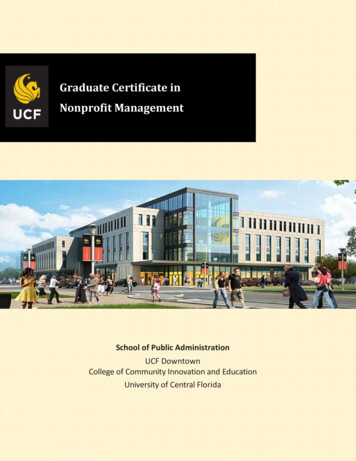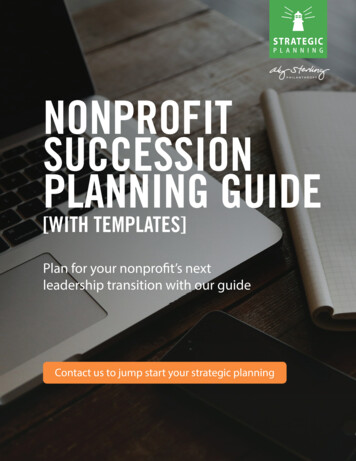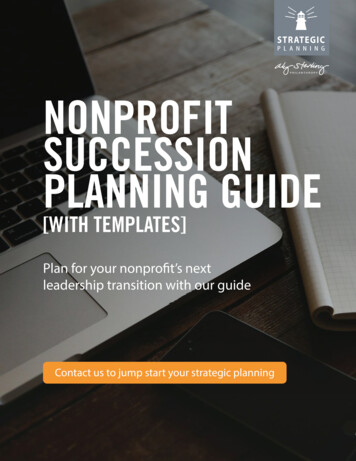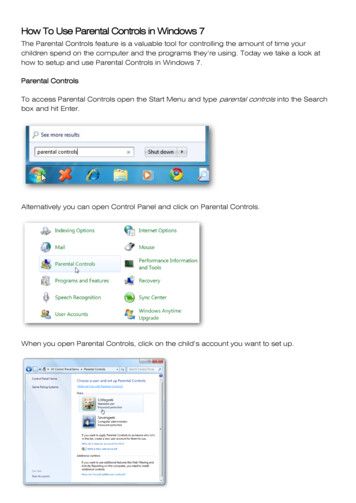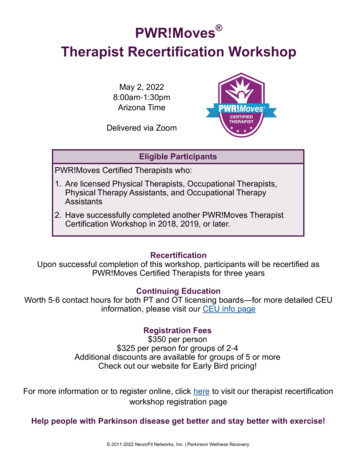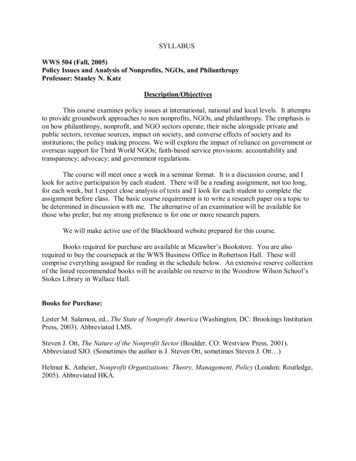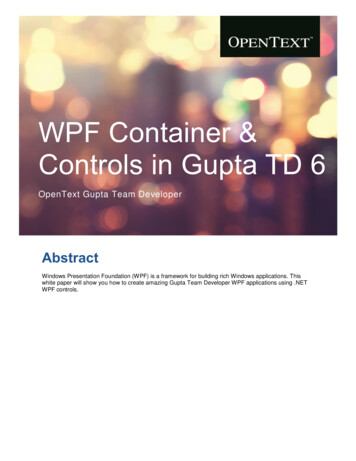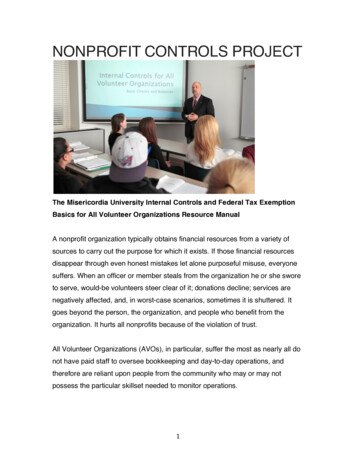
Transcription
NONPROFIT CONTROLS PROJECTThe Misericordia University Internal Controls and Federal Tax ExemptionBasics for All Volunteer Organizations Resource ManualA nonprofit organization typically obtains financial resources from a variety ofsources to carry out the purpose for which it exists. If those financial resourcesdisappear through even honest mistakes let alone purposeful misuse, everyonesuffers. When an officer or member steals from the organization he or she sworeto serve, would-be volunteers steer clear of it; donations decline; services arenegatively affected, and, in worst-case scenarios, sometimes it is shuttered. Itgoes beyond the person, the organization, and people who benefit from theorganization. It hurts all nonprofits because of the violation of trust.All Volunteer Organizations (AVOs), in particular, suffer the most as nearly all donot have paid staff to oversee bookkeeping and day-to-day operations, andtherefore are reliant upon people from the community who may or may notpossess the particular skillset needed to monitor operations.1
Steps can be taken by volunteer fire companies, churches, parent-teacherorganizations, youth athletic leagues, student clubs, and other nonprofit entitiesto mitigate their risk of errors and exposure to the theft of funds and/or services.Any lack of oversight is not fair to the organization, the community members itserves and, actually even the person who has volunteered to be the soleguardian of the organization's money. It is vitally important for nonprofits – nomatter the size – to implement some simple internal controls.What you will find inside:The faculty and the students of the Business Department at Misericordia haveput together this resource entitled the Misericordia University InternalControls and Federal Tax Exemption Basics for All-Volunteer OrganizationsResource Manual. As much as possible, the information, guidelines andrecommendations contained in this resource are provided and explained inlanguage designed for those with little or no background in accounting or finance.Examples and templates are included where appropriate. You will findinformation on how to access additional resources available on the Web and inprint.The first section of the Resource Manual is entitled Basic Internal Controls thatevery All Volunteer Organization should have. The controls covered in thissection represent the bare minimum that an organization should strive toimplement and maintain. Many of these are general in nature and encompass theentity as a whole, such as having more than one person involved in any activitythat involves cash, other assets and debts. There is also disclosure of simplecontrols specific to particular activities, such as collecting cash. In most cases,expansion of what can be done to provide additional checks and balances will beavailable in later sections of the resource and links to those will be embedded inthis first section. This first section on basic internal controls represents a2
manageable starting point for any organization no matter how small or large.Please read the Basics section first:Basic Internal Controls that every All Volunteer Organization should have.The other sections and subsections of this Resource Manual delve more deeplyinto specific internal controls for particular activities. They are as follows:Cash and Bank Accounts Collecting and depositing cash Payments made by check and cash Bank accountsoBank account reconciliationInternal reporting The treasurer's report Other internal reportsExternal reporting Internal Revenue Service reportingoReporting unrelated business incomeoMaintaining exempt statusPennsylvania reportingEvent Management Tax Exempt Status Applying for a Tax ID number Incorporating as a nonprofit Registering as a charitable organization Applying to the IRS for tax-exempt status Applying to Pennsylvania for exemption from paying sales taxAudits External audits and reviews Internal audits3
Note: This site is intended for the use of All Volunteer Organizations (AVOs) thathave no employees and typically have no physical office space available forexclusive use. The controls recommended have been designed for AVOs and insome cases would not be appropriate for larger nonprofit organizations. It isstrongly recommended all nonprofits in Pennsylvania consider joiningthe Pennsylvania Association of Nonprofit Organizations (PANO) that makesavailable to its members numerous excellent resources and training. The cost ofmembership in PANO is determined on a sliding scale based upon the size of theorganization.The following accounting students at Misericordia University have contributed tothis project facilitated by Dr. Fred J Croop, CPA, CMA, MBA, Dean of the Collegeof Professional Studies and Social Sciences: Samantha Baloga, Kevin Fitzgerald,Taylor Miller, Tia Miller, Linda Murphy, John Olenik, Nadine Pocceschi-regis,Merissa Reap, Sara Hogan Rutt, and David Smolsky. Many thanks to thepracticing accountants who were kind enough to be interviewed by the studentsand shared their expertise: William D. Durkin, Thomas Felver, Ray L. Knaub, Jr.,Brain T. Kelly, Barbara Sanders, and Michelle Valenti. Finally, specialappreciation also goes to Misericordia University professional staff membersJennifer Drouse, Stephen Filipiak, and Paul Krzywicki along with Standards forExcellence Director at the Pennsylvania Association of Nonprofit Organizations,Tish Mogan for all they have done to support the project.Fred Croop is available to speak to All Volunteer Organizations or other groupsabout the importance of implementing internal controls and safeguards in AVOs.Contact him atfcroop@misericordia.edu or (570) 674-6327.4
Basic Internal Controls that every All Volunteer Organization (AVO) ShouldHaveEstablish Joint Responsibility: More than one person should be involved inevery activity and transaction that involves cash, other AVO assets, andliabilities/debts. This can be accomplished in a variety of ways based upon thespecific activity or transaction and the officers and volunteers available to help.This will typically entail a modest level of extra effort and/or inconvenience butthe commitment is almost always worth the increased prevention of honest errorsand deliberate abuse that can damage the organization, itsofficers/members/volunteers, its benefactors, the beneficiaries, its work and thecommunity it serves. Be creative to reduce the burden; there are many ways toimplement this basic control with little imposition and recommendations onspecific activities and transactions are included in relevant sections of thisresource.Adopt and Publish the Rules: Written policies and procedures for the AVOshould be developed and made readily available to all officers, members andvolunteers. In addition, responsibilities and specific levels of authority andauthorization for everyone involved should be defined to which all must adhere.New officers, members and volunteers should be informed of all policies,procedures and limits of authority by providing and explaining the writtendocuments as soon as possible after they join the work of the AVO. All internalcontrols, such as the ones found in this resource, that have been adopted shouldbe included in the written policies and procedures of the AVO.Live by a Budget: The AVO should adopt an annual budget. The treasurershould include in his or her monthly report to the board how much has beencollected or earned toward budgeted receipts and revenues along with how muchhas been spent or committed to be spent toward each budgeted expense. At the5
end of the year, a final tally of budget versus actual should be produced andpresented to the board at the first board meeting of the next year.Require a Treasurer's Report at every Meeting: The Treasurer should providea written report to the secretary for the minutes at each board meeting. Thereport should be read to all in attendance and if someone wants a written copyarrangements should be made to provide it. The report should include atminimum: year-to-date receipts/revenues and payments/expenses compared tobudgeted amounts; the balances in all bank accounts; the balance of cash onhand; and any bills that have been received but not yet paid. In essence, theformat of the report should communicate the year-to-date profit and loss of theAVO in addition to the receipts and disbursements since the previous treasurer'sreport, not just the latter.Prepare Monthly Bank Reconciliations: A monthly bank reconciliation on eachbank accountshould be prepared by someone other than the treasurer,anyone who handles cash receipts and bank deposits (if different fromtreasurer) and anyone who pays bills by writing checks (if different fromtreasurer). This could possibly be another officer or a volunteer. The Treasurershould provide transaction details (deposits & checks) to the person who willreconcile the account and the bank statement should be mailed by the bankdirectly to the person who will prepare the reconciliation (or that person shouldhave electronic access to the bank statement). The person who reconciles theaccount should report on the most recent reconciliation at each board meeting.An explanation of how to prepare a bank reconciliation and a template to do soare included in the section of this resource entitled Bank Account Reconciliations.Have the Financial Records Audited: Audits by Certified Public Accountantsare expensive and most AVOs will not have the resources to afford an audit by aCPA. However, this is one of the best protections against undiscovered honest6
errors and deliberate misuse of AVO resources and if at all possible an audit by aCPA should be arranged. In a case where an audit by a CPA is not feasible, theAVO should have a yearly internal audit done by a small group of members orvolunteers (a two- or three-person audit committee) of the AVO who are notofficers and do not have any significant responsibilities for handling cash, otherassets, liabilities, making payments or deposits, etc. Recommendations on howto perform an internal audit are included in sectionAudits of this resource.Sometimes an AVO cannot afford an annual audit by a CPA but can manage topay for one every few years (for example, every third year). If this is possible theAVO can combine both approaches to audits, an independent audit by a CPAevery few years and internal audits by an audit committee in the interveningyears. If and whenever a CPA audit is performed, the CPA should report theresults to the audit committee who can then inform the board of the findings.The Treasurer should not have Conflicting Authority: The Treasurer of anAVO should never at the same time hold another office (such as President) of theboard, even temporarily.Rotate the Treasurer Responsibility: If at all possible, the Treasurer shouldhave a term limit of no longer than three years and, if reelected, should have atleast a two-year period between terms.Never have only one Person Count Cash: All cash receipts should beimmediately counted in presence of at least two people and the tally should besigned by all present. Cash should be deposited in a bank account as soon aspossible.Have Mail Opened by Two People: If at all possible, all mail to the AVO shouldbe opened in the presence of two or more people. This is quite often difficult butshould be seriously considered if donations or other receipts are routinelyreceived by mail.7
Endorse all Checks upon Receipt: All checks received should immediately beendorsed on the back "For Deposit Only" to the AVO name with the bank accountnumber of the AVO.Make all Payments by Check: All payments made by the AVO should be bycheck. Never pay bills with cash taken out of the receipts of an event.Require Two Signatures on Checks: Checks should require the signatures oftwo officers. This may not always be practical but should be the case as much aspossible. In order to handle smaller expenditures a checking account with a smallbalance that is never exceeded can be established where only one signature isneeded. Also, a small petty cash fund can be utilized. The policies, proceduresand processes for single-signature checking accounts and petty cash accountsare presented in the Payments Made by Check and Cash section of thisresource.Avoid the use of Credit and Debit Cards: The use of credit/debit cards is rifewith the potential for abuse. If at all possible, the issue of credit cards for use byan AVO should be avoided. If there is an unavoidable need for the issuance anduse of a credit card, a provider (bank/credit card company) should be securedthat will send an email notice to an AVO member who does not have access tothe card when: a transaction in an amount above a prescribed limit has occurred;a number of transactions in a day exceeds a prescribed number; and unusualtransactions (for example, payments to a clothing store) have occurred. Monthlystatements should be sent to someone without access to the card and should bereconciled just like bank statements.Two Rules of Internal Controls that Help: Each AVO is unique in one or moreways. This resource will not be able to address every situation and circumstancethat may be a part of the activities and operations of an AVO. Therefore, inconclusion to this list of basic controls that every AVO should have, it issuggested that the leaders of an organization adopt as a mindset two generalrules of internal control used by accountants and auditors that can guide thedevelopment of checks and balances in unique situations.8
Segregation of Duties – This is a variation of the "more than one personshould be involved in every transaction" basic control described earlier inthis section. This states that the recording of the transaction (typically theTreasurer) should be separate from the authorization for the transaction(typically the President or a committee of the AVO) and both should be, ifpossible, separate from the handling of the transaction itself (typically avolunteer or group of volunteers). Safeguarding of Physical Assets – Typically this means limiting accessto assets so that only authorized individuals have access for only thoseresponsibilities specifically approved for them per AVO policies. Exampleswould include: keeping the checkbook and blank checks locked up;keeping the keys to vehicles, buildings and rooms under specific control;keeping credit/debit cards in the hands of only those who are authorized touse them and preferably locked up when not in use; and keeping titles tovehicles, buildings and similar assets locked up.Internal Controls for Cash and Bank AccountsCash in the form of currency and coin represents the most vulnerable ofresources available to an AVO in carrying out its mission and purpose. Theredoes not have to be intentional actions in order for the AVO to suffer losses ofcash; honest individuals make mistakes, poor recordkeeping and documentationlead to cash unaccounted for, and the lack of strict procedures to keep AVO cashseparate from other cash (volunteers' personal cash) risks losses. Of course,though, unfortunately sometimes easy access to cash is just too much of atemptation for some individuals.Money received into an AVO in the form of checks, while less prone to lossthrough honest mistakes, and safer than currency, is still subject to the risk ofloss by individuals intent on relieving the AVO of some of its money.9
Access to the funds the AVO has in the bank can be had through using AVOchecks and AVO credit/debit cards. Controls to prevent inappropriate use ofthese are critical and procedures to detect errors (so that they can be corrected)or abuses (so that they can be stopped) as quickly as possible need to bedesigned carefully and implemented without fail. While corporations, larger nonprofits, and even small businesses, having the advantage of employees andstable physical locations, can create strong internal controls over cash on handand cash in the bank, AVOs have no employees and typically no designatedphysical location. Recommended controls in this resource to protect cash havebeen specifically designed for an AVO with no employees and no dedicatedphysical location and would not be appropriate for nonprofit organizations withemployees and/or an office location.Collecting and Depositing CashMoney Received through the Mail:-Stress with those who make donations, pay membership fees, or any otherpayments to the AVO that they should send only checks or money orderspayable to the exact name of the organization. This should be a prominentstatement in all materials and communications.-Use a post office box as the address for the organization. Provide keys to only alimited number of people (preferably only two) who can pick up the mail on aregular basis.-The person who picks up the mail from the P.O. box should not open it butinstead keep a tally of how many pieces of mail have been picked up.-The mail is taken to a person designated in the AVO's policies and procedures(a strong control would be that it would not be the Treasurer, if practical). The two10
should open the mail together and complete a list of what is received. (If the mailcan only be opened by the second person, the tally by the first person becomesthe compensating control as will be evident in a later step in the process.) Allchecks are immediately endorsed for deposit only to the AVO. A list of the mailhandled including the checks and any money received is completed as the mail isopened. It can be as simple as the example listing that can be found here.-The checks and money (not the list) is then delivered to the Treasurer forrecording, preparation of a deposit slip in duplicate, and deposited in the bank.Other mail that did not contain money is delivered to the appropriate person inthe AVO.-The tally of the number of pieces of mail picked up by the first person, the listingof mail opened and the deposit slip are all turned over to the person who willprepare the bank reconciliation (see Bank Account Reconciliations) to ensurethat all match and mail is accounted for.Money Received by Hand Delivery:Admittedly, this is very difficult to track and control. The AVO should specify in itspolicies and procedures that all money received by any officer, member orvolunteer should immediately be turned over to a designated person, typically theTreasurer. The AVO should adopt and make known to all that every person whodonates or pays money to the AVO will receive a receipt and that such receiptwill only be issued by the Treasurer, no one else.Money Received for Food or Merchandise at an Event:Very often AVOs will have food and merchandise stands or booths at events. Thekey controls are to have more than one person involved at all times, to count11
starting and ending cash on hand in the presence of two people, to safeguard allcash while at the stand and in transit in the most secure manner available(lockbox or safe), and to immediately deposit the receipts in the bank. Seerecommended internal control procedures for events in the section of thisresource entitledEvent Management. The following are actual procedures forhandling cash receipts followed by a youth athletic AVO in NortheasternPennsylvania (Courtesy of Linda Murphy, Misericordia Accounting Major): Registration Fees: Before the season starts the youth athleticorganization has several open registration sessions in which boardmembers and volunteers collect necessary documents and fees. All feescollected at each meeting are logged and counted by at least two peoplewith one being a board member. The money is then turned over to thetreasurer to be deposited in the bank. The log for all registrants reflectingthe total collected is attached to the bank deposit slip and the amount isrecorded in the bank ledger. Fundraiser conducted through the mail: A significant fund raiser issoliciting for team sponsors and advertising on the field. These receiptsare opened at a board meeting, logged into a spreadsheet, verified by twoindividuals, and deposited in the bank. Receipts at sporting events: It is impossible for a board member to bepresent at all games as they go on everyday for six to ten hours. The AVOrelies heavily on volunteers to work the snack stand which includes payingthe referees. All referee fees in sealed envelopes are provided to thevolunteers working the stand by the treasurer. The envelopes are markedaccording to the specific game date and time and kept at the snack standon a daily basis. At the start of the day, two volunteers must verify thestarting cash drawer and sign off on a daily sheet. All sales are recordedin a cash register to keep track of sales and control inventory. At the end12
of their shift, two volunteers must count the drawer back to the startingpoint, put all proceeds in the shift envelope, and drop it in a safe. Board members take turns emptying the safe each day, closing out theregister, and counting the receipts with a second board member orvolunteer present. The funds are deposited and logged in the ledger withthe deposit slip being attached to the daily report.Payments made by Check and CashAs stated in the Basic Controls section, the best system involves making allpayments by checks that requires two signatures.All large commitment of funds (anything above a predesignated dollar amountper the established policies and procedures of the AVO) should be approved inadvance by the full board at a board meeting. Other smaller payments andpurchases can be made prior to board approval by the designated co-signers ofchecks. All payments should be listed in the Treasurer's Report that is submittedfor approval at each board meeting.All payments to vendors should be made based only on invoices or bills, notmonthly statements. The co-signers of the check should sign it only aftermatching the invoice/bill to the check amount, verifying correct payee is listed onthe check and confirmation by an officer, member or volunteer that goods orservices have been received in good order. If it is impractical to pay small amounts by getting the signatures of twopeople, consider two alternatives:A second checking account can beestablished that requires only one signature, has a present maximumbalance (such as 200 or 500) and has printed on the checks: "Thischeck is not valid for amounts over 200." The designated person whomakes small payments with this account keeps receipts for what he or she13
has spent. At a board meeting, or before if the balance in the account getstoo low, he or she compiles all the receipts and submits them as evidencefor the issuance of a check from the main two-signature bank account todeposit back into the small single-signature account that will bring thebalance of the account back up to its preset maximum (again, such as 200 or 500). A lockable petty cash box that contains a preset amount of currency andcoin (such as 100) can be given to a designated officer, member orvolunteer who uses the cash from the box to pay for small purchases andputs in the box receipts/bills for anything paid out of it. At any point in timethe cash left in the box and the receipts/bills should total the presetamount (such as 100). At a board meeting, or before if the balance in theaccount gets too low, he or she compiles all the receipts and submits themas evidence for the issuance of a check from the main two-signature bankaccount to the petty cash person who can then cash the check and put thecash back into the box to bring the total currency and coin back up to itsfull preset amount (such as 100).Never pay for items out of the cash taken in at a food/merchandise stand. Alwayspay bills using a checking account or the petty cash box.Never sign blank checks.Never make checks out to cash.Keep unused checks under lock and key.Keep cash on hand under lock and key.14
Account for any voided checks. These should be given to the person preparingthe bank reconciliation.The following are actual procedures for handling purchases/paymentsfollowed by a youth athletic AVO in Northeastern Pennsylvania (Courtesyof Linda Murphy, Misericordia Accounting Major):In preparation for the season opening the AVO needs to issue checks for theuniforms, equipment, and signage. The bills are reviewed and approved by allboard members with the checks requiring two signors. To supply the snackstand, checks are issued after the invoices are reviewed and approved. All snackstand replenishment invoices and utility bills are reviewed and approved by theboard and checks are issued with two signatures.Bank AccountsAll money collected and all payments made should go through a checkingaccount. This provides a separate duplicate set of records maintained by anindependent bank for the AVO as a back up to the records kept by the treasurer.Any decision to open new accounts or investment (interest-bearing savings,certificates of deposit, brokerage/mutual fund accounts, etc.) should be approvedby the full board at a board meeting. Part of the approval process should be thespecification of responsible officers with regard to access and decision-makingpower over the new account(s).Signature cards should be updated immediately whenever signatories change.The supply of unused checks should be given immediately to the new officerresponsible for checks when responsibilities change. The new custodian ofchecks needs to ensure all unused checks are accounted for.15
It is at the time that new officers are chosen and responsibilities change thatmistakes and unfortunate discrepancies are more likely to occur so theimmediate reconciling of accounts and frequent monitoring of activity during thistime is recommended.Bank ReconciliationsThe purpose of a bank reconciliation is to account and adjust for any differencesbetween the financial records of checking account transactions kept for a monthby the treasurer of an AVO and the transactions recording by the bank for thechecking account. There will almost always be differences. Without trackingdown those differences to know exactly what they are, the leaders of an AVO willnever have confidence that they have control of exactly where the AVO standswith its cash resources. Contrary to popular belief by individuals with their ownpersonal checking accounts, bank reconciliations are not difficult to complete ifthey are done on a monthly basis and the differences are nailed down month bymonth.However, the real reason that the topic of a bank reconciliation is included in aresource on internal controls for AVOs isn't that it represents basic goodaccounting and bookkeeping, which it definitely does. The reason that it is soimportant for AVOs is that the preparation of a monthly bank reconciliation by aperson who does not handle the day to day management of a checking accountrepresents the single most important control in protection of the most vulnerableresource of an AVO, its cash. Bank reconciliations need to be prepared monthlyand completed (reconciled) within a short period (preferably ten days) after thebank statement day by a person who does not handle the checking account orthe financial records of the AVO. Period. So, the leaders of the AVO shouldreconcile themselves to setting up policies and procedures that are followed tothe letter to ensure that this is accomplished.16
Policies and Procedures:The bank reconciliation should not be prepared by the Treasurer. It is mostpractical that the President of the AVO prepare the monthly reconciliation. Itwould be preferable that it not be one of the signatories on the checking accountbut if it is (such as the President) it is imperative that each check require twosignatures.The President or whoever prepares the bank rec (accounting slang) reports that ithas been completed and all differences accounted for at the first board meetingthat occurs after the ten-day period to complete it has passed and that itreconciles to the balance of checking reported by the Treasurer.The bank should be instructed to send the bank statement directly to the homeaddress of the person who will prepare it; not to the address of the Treasurer orsome other address where mail is accessible by any member of the AVO otherthan the person preparing the bank rec. If there is online access to the bankstatement the person preparing the bank rec should have that access.The reconciliation will sometimes reveal adjustments that need to be made in thefinancial records of the AVO (such as interest earned posted by the bank, anNSF check deducted, a mistake by the Treasurer in recording the amount of acheck, fees deducted by the bank). The adjustments that need to be madeshould be communicated to the Treasurer as soon as practical.Preparation of a Bank ReconciliationWhat is Needed:17
The Bank statement for the month that includes a listing of the deposits and othercredits to the checking account and the listing of checks that were processed bythe bank along with any other debits (charges) to the accountThe up-to-date checking account ledger or "checkbook" that is kept by theTreasurerThe bank reconciliation prepared for the previous monthA template for the format of the bank reconciliation (One example isprovided here.)Steps in Preparing a Bank Reconciliation:1. Head up the template of the bank rec with the AVO name, the checkingaccount number and the ending date of the bank statement.2. At the top of the bank rec template write down the ENDING BALANCE foundon the bank statement (Note, make sure it is the ending balance and not thebeginning balance or some other subtotal on the statement.).3. Check off all the deposits on the bank statement matching them to the onesrecorded in the Treasurer's checkbook. There may be one deposit in thecheckbook (There really should never be more than one if any at all.) made at thevery end of the month that did not get to the bank in time for it to appear on thebank statement. This is c
Event Management Tax Exempt Status Applying for a Tax ID number Incorporating as a nonprofit Registering as a charitable organization Applying to the IRS for tax-exempt status Applying to Pennsylvania for exemption from paying sales tax Audits External audits and reviews Internal audits
